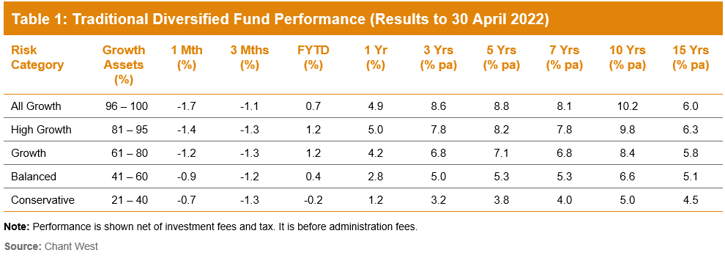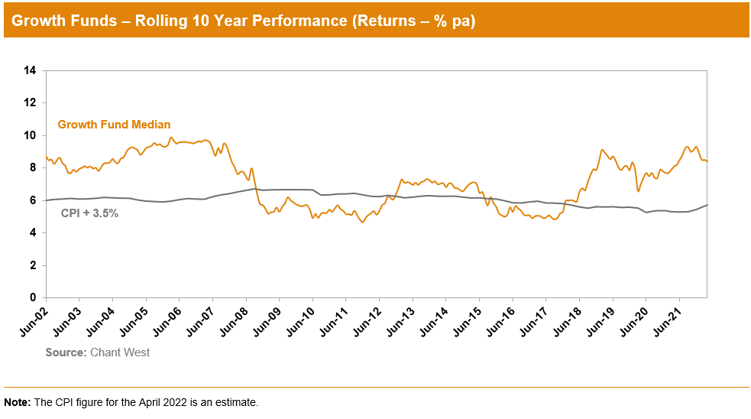Super funds took a step backwards in April, with the median growth fund (61 to 80% in growth assets) down 1.2% for the month. That reversed a similar gain in March and pulled the median return over first ten months of the 2021/22 financial year back to 1.2%. With share markets down so far in May we estimate that, with only about six weeks remaining, the financial year return is near break-even, at -0.5%.
Chant West Senior Investment Research Manager, Mano Mohankumar, says there’s naturally a lot of focus on financial year performance around this time of the year, but it’s important for super fund members to see things in context. “Even if growth funds do finish the year in negative territory, that would be only the fifth time in 30 years since the introduction of compulsory super in 1992. Whatever the result this year it will come on the back of the 18% return in FY21, which was the second best in the history of compulsory super. And even in FY20, which included the COVID-induced share market meltdown, the loss was limited to just 0.6%. So super funds have been able to navigate successfully through the worst of the pandemic, and members should take comfort in that. Even taking into consideration the losses in May to date, the median growth fund is still up more than 10% since the pre-COVID high at the end of January 2020.
“Looking back over the past decade, we’ve seen an unusually strong run of returns averaging 8.4% per annum. That’s been great, but members shouldn’t expect performance to continue at that sort of level. It’s not sustainable and it’s not what these funds are designed to achieve. The typical long-term return objective for growth funds is to beat inflation by 3.5% per annum. That translates to about 6% per annum in absolute terms.
“The losses in April were mainly driven by international share markets which plummeted 7% in hedged terms on worries about the ongoing war in Ukraine, lockdowns in China, continued supply chain disruptions and expectations that US interest rates could be lifted sharply to control inflation. The depreciation of the Australian dollar provided some cushioning, reducing the unhedged loss to 3.2%. Australian shares fared much better, falling just 0.8%. Bonds continued to suffer as yields rose again, with Australian and international bonds losing 1.5% and 2.9%, respectively, over the month.”
Table 1 compares the median performance for each of the traditional diversified risk categories in Chant West’s Multi-Manager Survey, ranging from All Growth to Conservative. All risk categories have generally met their typical long-term return objectives, which range from CPI + 1.75% for Conservative funds to CPI + 4.25% for All Growth.

Lifecycle products behaving as expected
Mohankumar says that while the Growth category is still where most people have their super invested, a meaningful number are now in so-called ‘lifecycle’ products. “Most retail funds have adopted a lifecycle design for their MySuper defaults where members are allocated to an age-based option that’s progressively de-risked as that cohort gets older,” he said.
“It’s difficult to make direct comparisons of the performance of these age-based options with the traditional options that are based on a single risk category, and for that reason we report them separately. Table 2 shows the median performance for each of the retail age cohorts, together with their current median allocation to growth assets. For comparison purposes it also includes a row for traditional MySuper Growth options – nearly all of which are not-for-profit funds. Care should be taken when comparing the performance of the retail lifecycle cohorts with the median MySuper Growth option, however, as they’re managed differently so their level of risk varies over time.”

Despite the share market falls this calendar year, options that have higher allocations to growth assets have done better over most periods shown. Younger members of retail lifecycle products – those born in the 1970s, 1980s and 1990s – have generally either outperformed or performed in line with the MySuper Growth median over the one-year period and longer. However, they’ve done so by taking on significantly more share market risk. On average, these younger cohorts have at least 20% more invested in listed shares and listed real assets than the typical MySuper Growth option.
The 1960s cohort has generally underperformed the median MySuper Growth option. This is partly due to a lower allocation to growth assets up until recently, when lifecycle product providers revised their glide paths to delay the de-risking process until older ages. Another reason for this underperformance is a lower allocation to unlisted assets, which have performed well, and a higher allocation to traditional defensive asset sectors, such as bonds and cash, which have been the weakest performing sectors since the introduction of MySuper.
The oldest cohorts (those born in the 1950s or earlier) are relatively less exposed to growth assets so you would expect them to underperform the MySuper Growth median over longer periods. Capital preservation is more important at those ages, so while they miss out on the full benefit in rising markets, older members in retail lifecycle options are generally better protected in the event of market weakness.
Long-term performance remains above target
MySuper products have only been operating for eight years, so when considering performance it’s important to remember that super is a much longer-term proposition. Since the introduction of compulsory super in 1992, the median growth fund has returned 8% p.a. The annual CPI increase over the same period is 2.5%, giving a real return of 5.5% p.a. – well above the typical 3.5% target. Even looking at the past 20 years, which now includes three major share market downturns – the ‘tech wreck’ in 2002–2003, the GFC in 2007–2009 and COVID-19 in 2020 – the median growth fund has returned 7% p.a., which is still well ahead of the typical return objective.
The chart below shows that, for the majority of the time, the median growth fund has exceeded its return objective over rolling 10-year periods, which is a commonly used timeframe consistent with the long-term focus of super. The exceptions are two periods between mid-2008 and late-2017, when it fell behind. This is because of the devastating impact of the 16-month GFC period (end-October 2007 to end-February 2009) during which growth funds lost about 26% on average.

International share market returns in this media release are sourced from MSCI. This data is the property of MSCI. No use or distribution without written consent. Data provided “as is” without any warranties. MSCI assumes no liability for or in connection with the data. Product is not sponsored, endorsed, sold or promoted by MSCI. Please see complete MSCI disclaimer.



